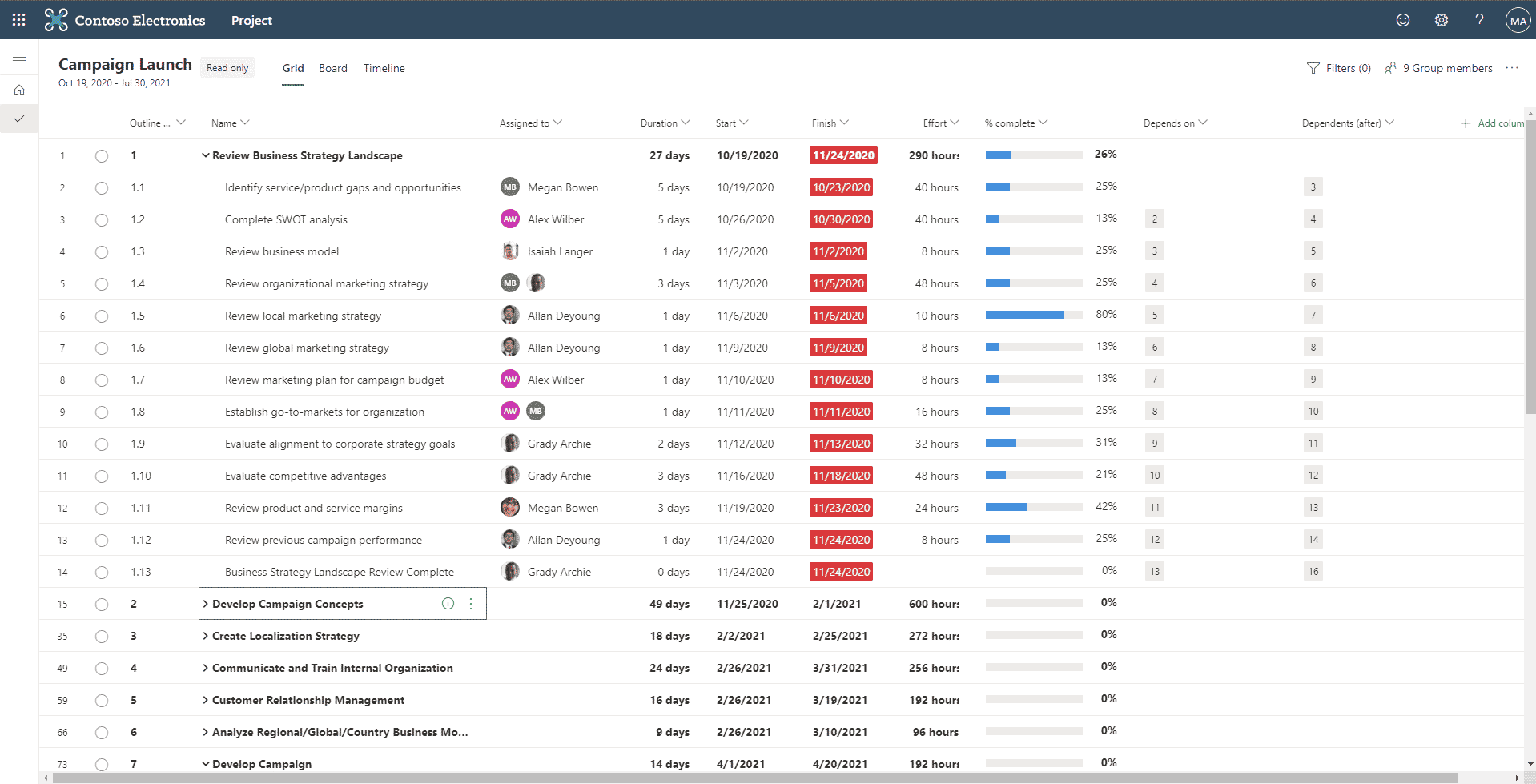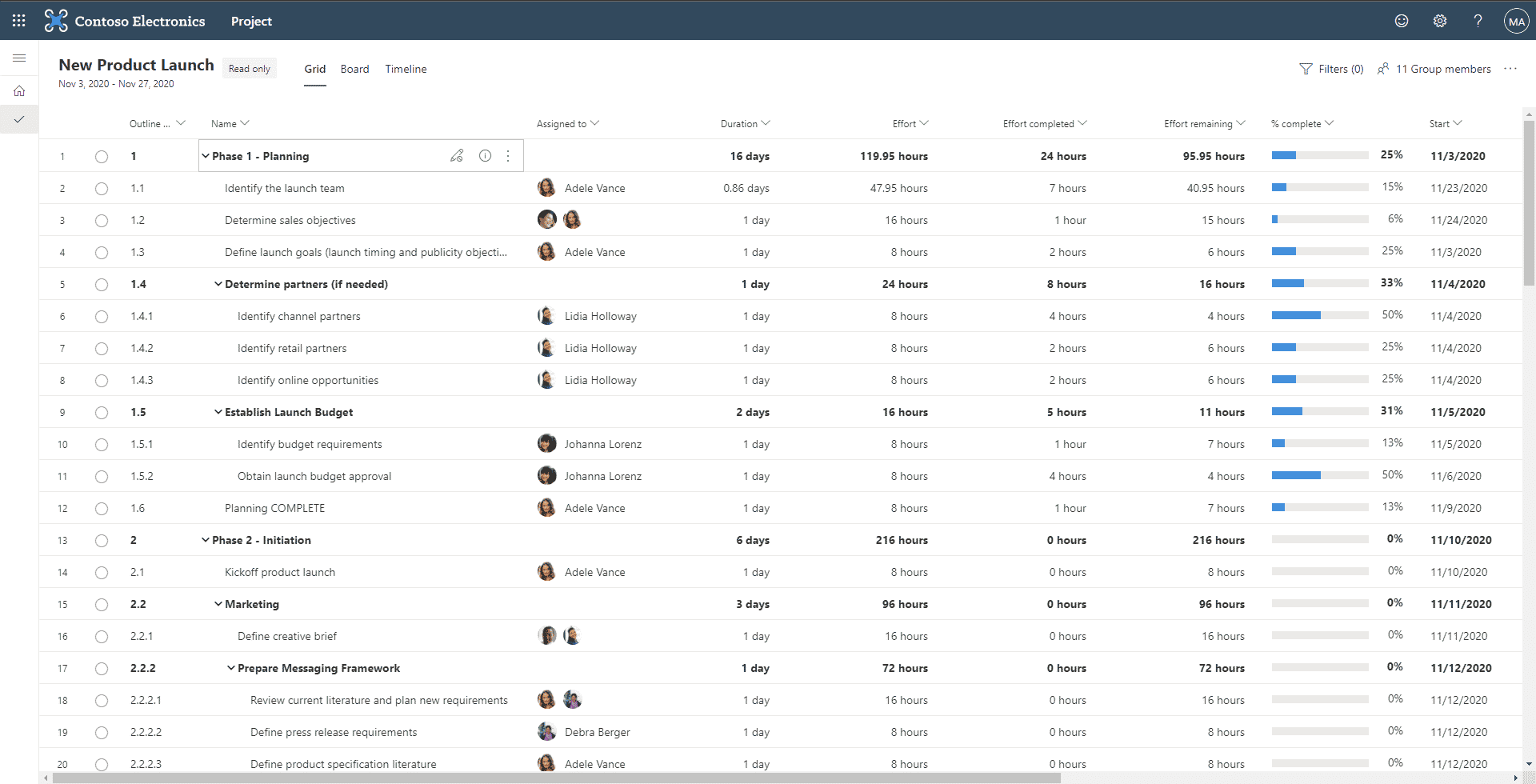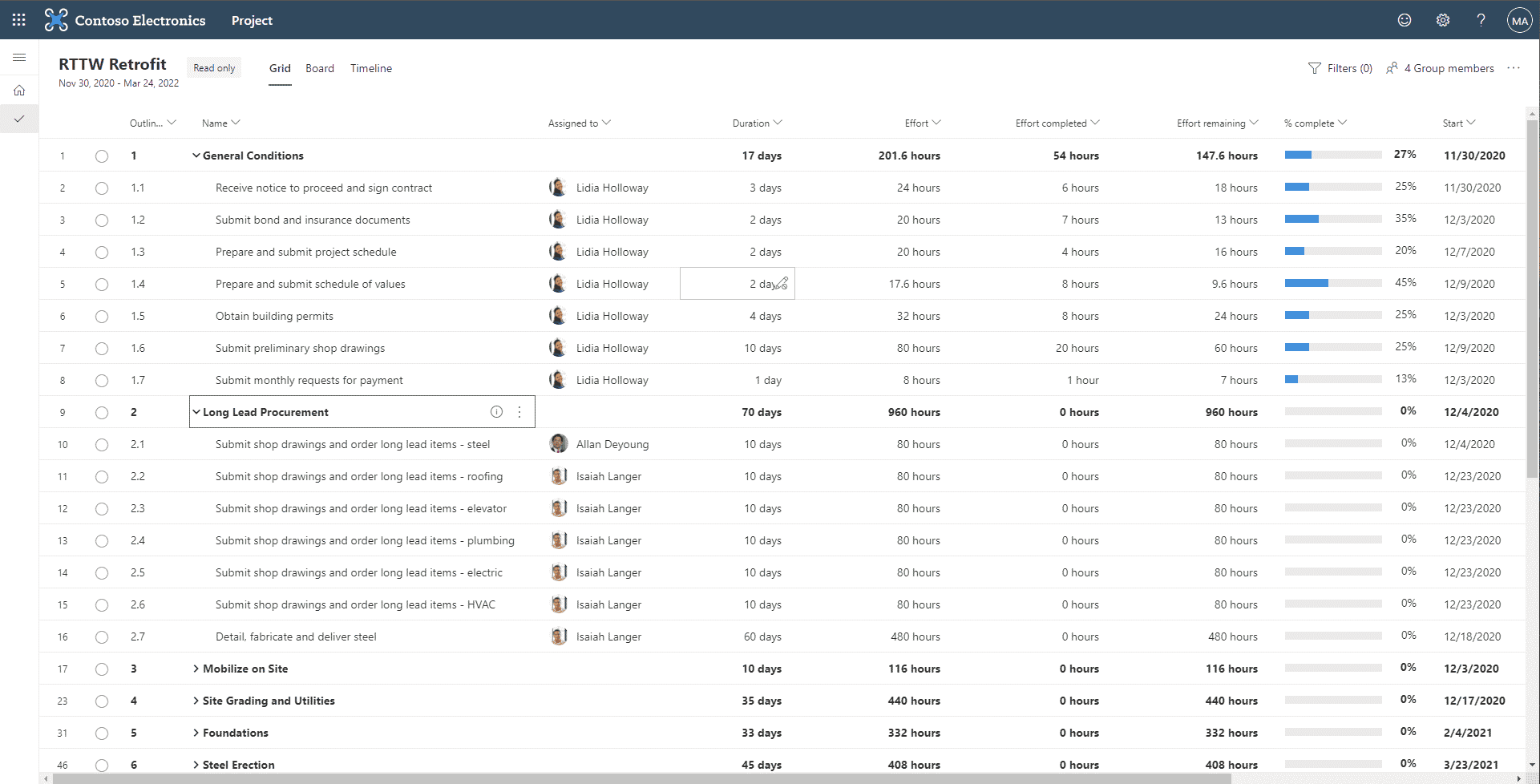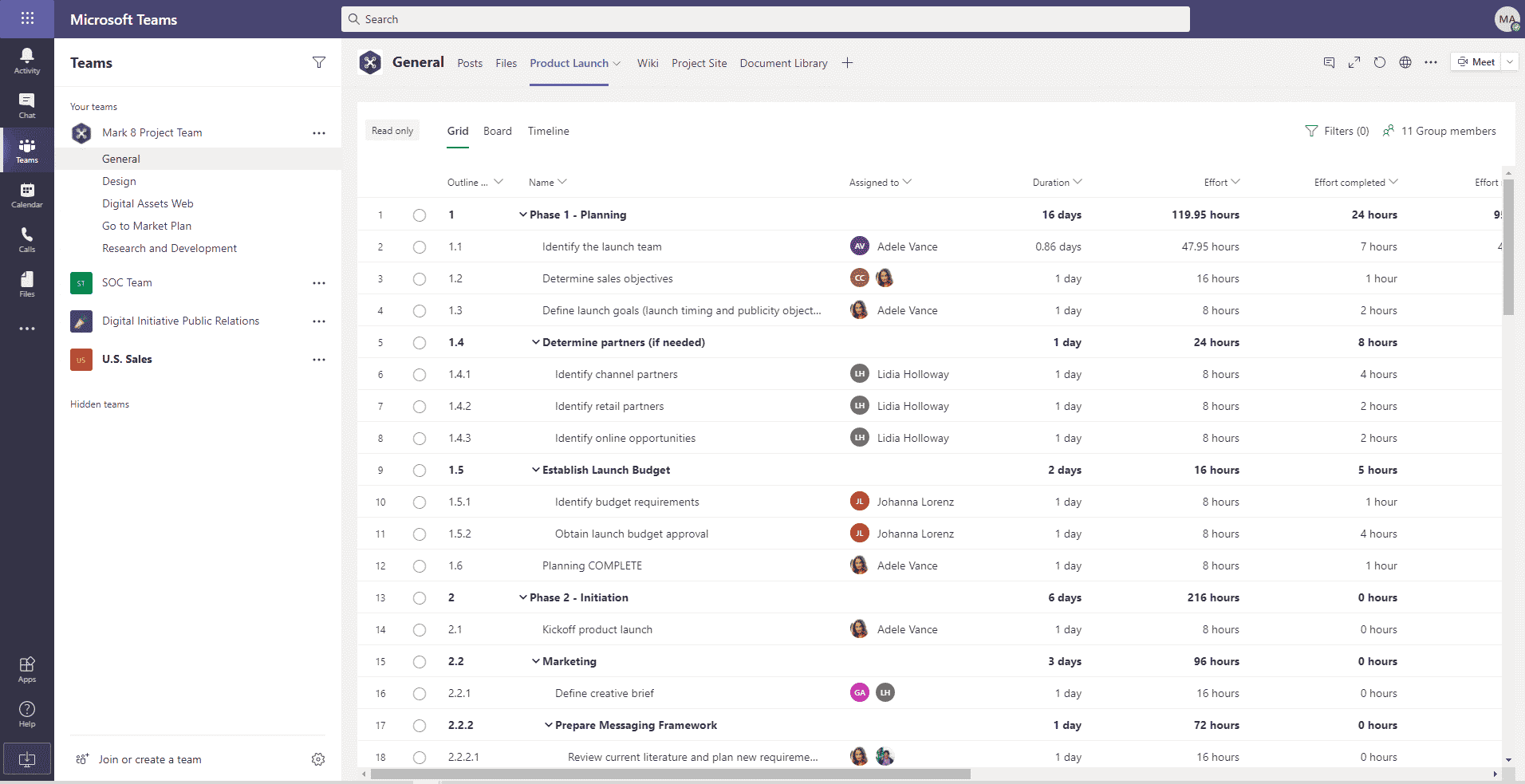Working together
Whereas traditional approaches to project management have been standardised and used extensively since the 1950s, prevailing challenges due to the pandemic have imposed greater problems and risk to informal project management practices. We understand “informal project management” not as chaotic or disorderedly execution of work but as project management practices that manage the same aspects of time, quality and cost but do not adhere to a rigorous standards and rules for managing a project.
This article outlines the benefits of using Project for the Web for the informal project manager, exemplified in the ways it improves the everyday effectiveness of three different roles: the marketing manager, the product manager, and finally, the facilities manager.
Current challenges in the way we work
The current pandemic has challenged the way we work, forcing professionals to operate in new demanding ways, while previously the traditional office, factory or facility environments helped to promote collaboration and commitment, the current operational reality requires better ways to get results and be effective.
Current requirements for collaboration involve dispersed teams working spread across a global office or facilities network, with additional challenges imposed by this modern workplace: changes in technology, new organisational structures or informal management styles requiring nonetheless the same (or more) level of effectiveness than before.
Additionally, there is an increased challenge to address the needs of professionals operating in teams with informal project management styles or requirements.
Enter Microsoft Project for the Web: a better way to collaborate and get results in the modern workplace
The previously mentioned challenges have been traditionally met using project management frameworks and software solutions requiring adherence to formal structures and strict disciplined approach. However, nowadays, informal, ad-hoc teams are striving for more accountability, while retaining flexibility to accommodate different use cases, project management styles and types of projects. Also, readiness is of the essence, and a modern IT infrastructure must be available.
How can we address the challenges of the informal project managers to drive execution results? In targeting these needs, Microsoft has designed Project for the Web: a simple, intuitive, yet powerful and scalable platform for managing any type of work.
Project for the Web
Project for the web is Microsoft’s most recent offering for cloud-based work and project management. Project for the web provides simple, powerful work management capabilities and can be used by project managers and team members to plan and manage work of any size.
Built for convenience, collaboration, and accountability
Project for the web is built on the Microsoft Power Platform and made available to users directly in Office 365. The Power Platform consists of PowerApps, Microsoft Flow, Power BI, and the Dataverse (previously named Common Data Service or CDS). Project for the web data is stored in Dataverse.
Project for the web is built on Microsoft 365 Groups, so it works with any Microsoft 365 tools you use to collaborate with your teammates on projects in a Microsoft Cloud. Current licensing of Project for the web allows anyone in Office 365 to be assigned a project a task. Users with a Project Plan 1, 3, or Plan 5 licenses can additionally manage Project for the web projects and tasks.
Since Project for the web is an online lightweight online scheduling engine, Informal Project Manager can drive accountability to task completion by using the effort, duration and start and finish dates as part of the project team task scheduling. Project for the web also integrates natively into Microsoft Teams, therefore enabling collaborative work management in the organization.
Using Project for the web in Teams allows the entire Project team to leverage OneDrive, SharePoint and the rest of Office 365 to meet all collaboration requirements. In the next section, we will review three distinct roles employing informal project management styles to see how Microsoft Project for the web can help them in their everyday project management needs and requirements.
The Marketing Manager
Everyday challenges, everyday results, always in control
Working in partnership with the creative teams, develop creative content and guide creative direction to meet marketing objectives is really challenging without a go-to, intuitive and easy to use project management tool like Microsoft Project for the Web.
Project for the web is a cost-effective, Office-based, ready-to-use service within Office 365, and as simple as requesting a license. These features are especially convenient for collaborating in a creative team.
A marketing manager must conceptualize and execute campaigns across a customer’s lifecycle. Project for the web allows for the creation of projects requiring a grid view, dependencies, scheduling, and a timeline (Gantt) view.
Marketing campaigns can be created easily inviting the right people to come together and collaborate and displaying progress using a timeline view for increased visibility and accountability.
Using a project bucket view, marketing managers can gather customer and market insights to inform outreach strategies, moving from a “backlog” to a “to-do”, “doing” or “done” stage, to increase customer conversions, and generate more qualified leads.
Finally, as one example of its capabilities, using Microsoft for the web, the managers can present ideas and final deliverables to internal and external teams in Microsoft Teams, and communicate with senior leaders about marketing programs, strategies, and budgets.
Try Microsoft Project for the Web to help you stay in control with a powerful, easy-to-use project management app and reach easier your marketing goals.

The Product Manager
The challenge to create the right products, collaborate effectively while meeting deadlines
The Product Manager is responsible to make the right products “come alive” to address the best market needs representing profitable business opportunities while also delivering increasingly complex initiatives with fewer resources and in shorter timescales.
The Product Manager is ultimately responsible for managing the product throughout its lifecycle –from inception through end-of-life–, the manager collaborates in meeting product deadlines. Using Project for the Web, the Product Manager can create collaborative product roadmaps. A clear product roadmap, easily accessed in web or in Teams, and available to all stakeholders (designers, developers, quality assurance engineers, supply chain and operations experts) increases accountability and resolves focus and alignment problems. This is particularly critical on a time of increased global competition.
In the head of a typical Product Manager there is a recurring question: how to achieve and deliver under overwhelming time constraints? A Product Manager uses Project for the web to scale from managing team projects to large-scale complex initiatives. Using the timeline view, the Product Manager can share progress to stakeholders and align the team while also assigning project tasks for increased accountability and measure work and effort.
Product Managers often must be ruthless to prioritize while balancing the needs of customers and stakeholders: without clear visibility of the milestones, priorities, and tasks it’s challenging to say “yes” or “no” and stay course. Competitive product management requires more than updating a spreadsheet: for example, trying to track dependencies can become a nightmare. Microsoft for the web excels at providing a convenient grid view that allows stakeholders and team members to be aligned and track progress.
One interesting demand that Product Managers face is that they are given a lot of responsibility but usually with little or no authority. Conflicting priorities, dispersed team members, and a lack of visibility can be not only time consuming but can possibly hinder a product’s success. Microsoft for the web enables the product’s teammates work using board capabilities to accommodate a Kanban style of project/product management or manage tasks and milestones in buckets (task/milestone containers). These capabilities are readily available and as simple as requesting a license… all within the Office 365 and Microsoft Power Platform.

The Facilities Manager
Ensuring a balance in meeting expectations, costs, and time
In the current pandemics landscape, facility management -specially addressing the safely return of occupants to the work facilities- requires frameworks and tools to speed up execution and add more value to the organization. The facility manager needs to manage all facility activities, control schedules, manage contracts, and develop contingency, RTTW and security plans, and manage external contractors, among other responsibilities. Facilities managers often work in diverse multi-disciplinary teams of staff including cleaning, maintenance, grounds, and security, among others.
A good facility manager is responsible for the security, maintenance, and services of work facilities to ensure that they meet the needs of the organisation and its employees. Attention to detail is critical but also the ability to see the implications for the bigger picture. A typical question facing a Facilities Manager is often of this style: how can a diverse set of requirements, inspections, projects be managed more efficiently?
Microsoft Project for the web allows Facilities Managers to provide greater accountability and traceability by taking advantage of work grids to measure work, work completion and dependencies… all within a familiar Microsoft Office 365 environment. Whether in a web, mobile or Teams environments, teammates and facilities managers can collaborate easily and track effort, duration, dependencies, and milestones.
To be exceptionally conscientious and diligent allows a Facilities Manager to stay on top of their day-to-day operations, however, good project management practices and the power of Microsoft for the web can elevate their performance to new plateaux.
As an example of Microsoft for the web capabilities, a Facilities Manager can define a project, create specific fields to manage it (operational readiness, business continuity, safety protocols, etc.), posted it in Teams, access it using the mobile version, review a timeline with the leadership team.

Getting started
As outlined by the roles and examples of the previous section, Microsoft for the web is an Office 365, easy to use, flexible solution that can accommodate different project management styles. Informal project managers work with Project for the web in the Office 365 cloud delivering business outcomes through project and task accountability. The organization achieves more by having Office 365 users as Project team members in Project for the web planning and tracking work with task assignments. From a security standpoint, the organization ensures that users and data are protected by Office 365 security.
Finally, using Project for the web in Office 365 provides extensibility to the business application capabilities of Power Apps, Power BI and Power Automate. Take advantage of Microsoft Project for the web, by subscribing to Microsoft Project Plan 1, Plan 3 or Plan 5.
Project for the web is included in the above subscriptions and the first step is creating a new project by accessing, try it and see what it can do for you:

About OnePlan
OnePlan Solutions is a trusted global provider of digital transformation services and solutions, with expertise in portfolios of products, services, and projects. OnePlan is your “one-stop-shop” for business agility transformation in portfolio management with implementation services, education and training, customer support and advisory services. We strive to maximize your business outcomes and to create the shortest path to value.
In 2019 and 2020, OnePlan was awarded the Global Microsoft Project and Portfolio Management Partner of the Year award and finalist demonstrating breakthrough customer impact and solution innovation.
Our numerous Microsoft credentials includes –among others– Microsoft Project and Teams, Microsoft Dynamics 365 and the Power Platform, as well as key certifications in the Scaled Agile Framework.

